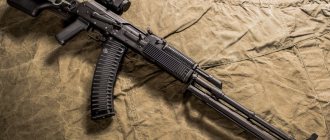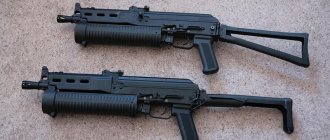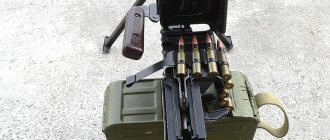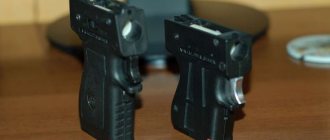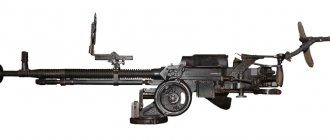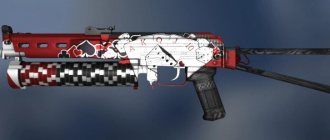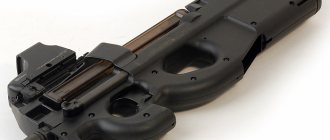The Utes machine gun is a direct descendant of the legendary DShK.
“Degtyarev-Shpagin large-caliber” was originally intended to destroy enemy aircraft at altitudes of up to one and a half kilometers. It was a great success for the Soviet Army that the ancestor of the Utes machine gun was put into service on the very eve of the Great Patriotic War. Indeed, in addition to its main function - the fight against enemy aircraft, it successfully supported infantry with its devastating fire, covered armored vehicles and ships. With the end of the war, his service continued for several more decades.
Utes's ancestor - the legendary DShK
New times - new requirements
By the end of the 50s, it became clear that the DShK needed a replacement, one that was lighter, more mobile, more technologically advanced, and fully met the requirements of modern (at that time) combat. Developed by the famous Tula gunsmith designers G.I. Nikitin, Yu.M. Sokolov and V.I. Volkov, the Utes machine gun in its other name inherited the first letters of the surnames of its creators - NSV, and from its great predecessor DShK - caliber 12, 7 mm. Its combat “competence” includes lightly armored targets such as armored personnel carriers, firing points, concentrations of infantry, vehicles and low-flying targets. The fire's reach limit is from 1 to 1.5 km.
The seriousness of the intentions of the Soviet defense industry is evidenced by the fact that for the production of the NSV-12.7, a completely new one was built in the city of Uralsk. The core of the team consisted of engineers and workers from leading Soviet weapons enterprises.
History of creation
“Utes” was a replacement for the large, inconvenient and structurally outdated DShK. The Tula plant TsKIB LLC took on the development. The machine gun was developed in the 60-70s. The machine gun was developed by three engineers - Nikitin, Soloviev and Volkov. This is where its name “Cliff” NSB comes from, where the first letters symbolize the surnames of the developers. The same developers previously participated in a competition to create a machine gun with a 7.62 mm caliber, however, it was won by M.T. Kalashnikov.
After the presented weapons, it was decided to build a plant in Uralsk, specifically for the production of such machine guns. Initially, they wanted to produce it at the Kovrov enterprise, but since it was fully loaded, there was a need for another enterprise.
The NSV Utes machine gun was assembled using new technologies that were brought together from all over the USSR.
- First, electromechanical machining was used to create the rifling.
- Secondly, thermal tempering was carried out using a vacuum system.
- Thirdly, the durability of the barrel was extended through the use of jet chrome plating.
Ultimately, the weapon was adopted in 1971. It was constantly tested, due to which constant amendments were made to the design, which increased the efficiency, service life, and also simplified the machine gun. A few years later, Utes began to be supplied to neighboring republics.
Design Features
Like the DShK, the 25-kilogram “Utes” is completely “self-sufficient”. It receives energy for automatic operation thanks to powder gases. The trigger mechanism is very simple in design, located in a separate box and can provide exclusively automatic firing.
The machine gun barrel is easily removed. For ease of transportation, it is equipped with a handle, and a conical flash suppressor is installed at the end of its muzzle. For the field version, designers K. Baryshev and L. Stepanov developed a 6T7 tripod machine. In the manufacture of barrel rifling, jet chrome plating technology was used to overcome high thermal loads.
A series of ammunition was developed specifically for Utes to hit specific targets. Thus, the incendiary 43-gram MDZ cartridge was created to destroy low-flying targets and vehicles, and the 55-gram BS armor-piercing incendiary cartridge with a refractory metal core was created for lightly armored vehicles.
Cartridges for the Utes machine gun
Later, more powerful ammunition of the 12.7 x 108 mm series was created, which included the B-32, BZT-44 and MDZ cartridges. At a distance of half a kilometer, the Utes confidently penetrates 16 mm armor. Machine gun belts for field and tank versions hold 50 and 150 rounds, respectively.
Utes machine gun on the T-72 tank
Modifications
The use of the machine gun arsenal of the Soviet Army was striking in its diversity. On the basis of the Utes, several types of easel weapons were created, which are still used today. The developments of domestic designers were used far beyond the borders of the Union. For example, in the early 90s, several thousand units of Finnish armored vehicles operating under the UN logo on the African continent were armed.
The most common modifications of this type of weapon are as follows:
- NSVS 12.7 – infantry mounted weapon;
- NSVT - a tank version installed on many types of armored vehicles;
- "Utes-M" - a gun for the Navy, equipped with 2 machine gun units;
- WKM-BM – Polish model for NATO cartridge 12.7*99.
NSVT
It gained the greatest popularity under the NSVT label, installed on tanks, self-propelled vehicles and armored vehicles, under the guise of machine-gun and anti-aircraft weapons.
NSVT machine gun
A distinctive feature from other modifications is that this gun is equipped with an electric trigger. It consisted of a coil mounted on a rod, housed in a sealed boot.
Attached to the back of the receiver, when voltage is applied, the rod moves forward and presses on the trigger mechanism. In addition, the weapon received remote power, and the shooter’s orientation at the time of shooting was carried out through the machine’s triplexes.
Infantry
The characteristics of the Utes infantry machine gun were used in several cases. The most successful in this situation was the use of weapons from the Baryshev-Stepanov machine gun.
A number of night vision optical sights were manufactured for them. The machine and equipped with NSVK were equipped with original shock absorbers installed on the coulter front shovel. As a result, the shooter involuntarily squinted at the moment of the shot, which provided for a second delay at the moment of shooting.
Machine gun Utes
The rollback of the system was quite noticeable, which required the installation of a shock absorber and a sight that moved simultaneously with it.
The official position of the shooter was in a simultaneous prone or kneeling position. Otherwise, the gun would spontaneously “goat” due to the vertical position of the shock absorber.
Utes-M
The official name is “Turret-turret installation Utyos-M”, the first prototype was manufactured in 1972. It was equipped with 2 standard NSV 12.7 machine guns located in the horizontal direction. In the same year, official tests of a new type of weapon intended for the USSR Navy began.
NSV 12.7
After further modifications and test firing, the gun was put into mass production, and a year later it was put into service; this happened in 1975. It was successfully used on hovercraft, boats, and ekranoplanes.
Participation in conflicts
During its more than 40 years of service, Utes managed to fight in Afghanistan and Chechnya. In particular, in Chechnya the nickname “anti-sniper” stuck to him. A long firing range (up to 2 km), stealth in combination with a special sight makes the Utes an effective means of combating enemy snipers. The combat capabilities of the machine gun increased significantly when sights began to be installed on it - optical SPP, night unilluminated NSPU-3 and radar sight, allowing targeted fire in the dark.
Combat use
The NSV "Utes" was first used in Afghanistan by the Soviet military. Initially, both sides used DShK, but NSV appeared in the second half. The new machine gun was warmly received by the soldiers, primarily for its ability to conduct aimed fire at a long distance, which did not allow the enemy to get close enough to fire effectively from machine guns.
Due to its light weight, the machine gun was often loaded with bags of sand or stones.
Each machine gun had an optical sight and a night vision installation. Such components significantly improved visibility of the location.
Due to too much noise when firing, the shooter was periodically replaced as the weapon caused too much acoustic impact.
The machine gun was used in the Chechen company. Algerian military personnel stated that the NSV operated successfully at air temperatures of more than 50 degrees, in sand and mud. The Malaysian military used the machine gun uninterruptedly during rainstorms.
Tactical and technical characteristics of the Utes machine gun
- Cartridge - 12.7 x 108 mm
- Machine gun weight without belt - 25 kg
- Barrel weight - 9 kg
- Weight of loaded belt with a capacity of 50 rounds - 7.7 kg
- Weight of the cartridge box equipped with 50 cartridges - 11.1 kg
- Cartridge weight - 123-137 g
- Machine gun length - 1560 mm
- The length of the machine gun with electric trigger is 1610 mm
- The length of the machine gun on the 6T7 machine is 1900 mm
- The height of the machine gun on the 6T7 machine is 380 mm
- Number of grooves - 8
- Initial bullet speed - 845 m/s
- Muzzle energy of a bullet - 15815-17672 J
- Fire modes - continuous
- Rate of fire (technical rate of fire) - 700-800 rpm
- Combat rate of fire - 80-100 rpm
- Sighting range - 2000 m
- Direct shot range at a target 2 m high - 850 m
- The thickness of pierced armor at a distance of 500 m is 16 mm
- Belt and cartridge capacity: infantry version - 50, tank version - 150
Main foreign analogue
The main competitor in the arms market is the Browning M2. This American machine gun was developed back in the 1920s. It is used by most countries that were not previously associated with the Soviet Union. Browning's cartridge complies with the NATO standard - 12.7x99. Without the machine gun, the machine gun weighs 38 kg, and with it 58 kg. The weapon can fire approximately 500 times per minute. The short stroke of the barrel is the basis of the automatic action.
Browning is superior to NSV in some respects. For example, the speed of a bullet when leaving the barrel is 930 m/s, while the NSV is “only” 800 m/s. With all this, the Soviet cartridge case is slightly larger than the NATO case (12.7 × 108 mm versus 12.7 × 99 mm). The Browning's higher launch speed allows it to penetrate thicker armor.
Photo NSV-12.7 Cliff
12.7 mm NSV "Utes" heavy machine gun on a 6T7 machine gun
Similar
AK-47 assault rifle cartridge caliber 7.62 mm.
Device. Rate of fire AK-74 assault rifle cartridge 5.45 mm caliber. Device. Rate of fire
Dragunov SVD sniper rifle caliber 7.62 mm. Device
AKS-74U assault rifle cartridge caliber 5.45 mm. Device. Weight
Mauser K96 pistol cartridge caliber 7.63 and 9 mm. Device
Pistol Walter PP / PPK cartridge caliber 7.65 and 9 mm. Device
Pistol Yarygin PYa Grach cartridge caliber 9 mm. Device
DShK machine gun cartridge caliber 12.7 mm. Device. Rate of fire
Luger pistol R.08 Parabellum cartridge caliber 9 mm. Device
Pistol PM cartridge caliber 9 mm. Rate of fire. Dimensions. Bullet speed. Sighting range
Self-loading shotgun Saiga-12 cartridge, caliber. Device
Maxim machine gun cartridge caliber 7.62 mm. Device. Weight
PPSh-41 Shpagina submachine gun cartridge caliber 7.62 mm
APS Stechkin pistol cartridge caliber 9 mm. Device
Nagan system revolver cartridge caliber 7.62 mm. Device
Kalashnikov PK machine gun and PKM cartridge caliber 7.62 mm. Device
Simonov carbine SKS-45 cartridge caliber 7.62 mm. Device
Rifles and carbines Mauser 98 caliber 7.92 mm. Device
PPS-42 and PPS-43 Sudaev submachine gun cartridge caliber 7.62 mm
Pistol Walter P38 cartridge caliber 9 mm. Device
MP-40 German submachine gun cartridge caliber 9 mm. Device
VSS Vintorez sniper rifle caliber 9 mm. Device
Submachine gun PP-91 Kedr cartridge 9 mm caliber. Device
Light machine gun RPK-74 cartridge caliber 5.45 mm. Device
Pistol Glock 17 cartridge caliber 9 mm. Device
Makarych, Izh-79-9T, MR-79-9TM, MP-80-13T traumatic pistol
AK-12 assault rifle cartridge caliber 5.45 mm. Device. Weight
Mosin rifles and carbines Three-line caliber 7.62 mm
PMM Makarov pistol modernized 12 rounds. Device
Revolver Colt Single Action Army (SAA) Peacemaker. Device
Machine gun PKP Pecheneg cartridge caliber 7.62 mm. Device
Sniper rifle VSSK Exhaust caliber 12.7 mm. Device
Beretta pistol 92 cartridge caliber 9 mm. Device
TT - Tokarev pistol cartridge caliber 7.62 mm. Device
Submachine gun PP-19 Bison cartridge caliber 9 and 7.62 mm. Device
Sniper rifle SV-98 caliber 7.62 mm. Device
Vladimirov KPV machine gun cartridge caliber 14.5 mm. Device
ASH-12 assault rifle cartridge caliber 12.7 mm. Device. Rate of fire
PSM pistol cartridge caliber 5.45 mm. Device
Pistol Colt M1911A1 cartridge caliber 45. Device
Smith-Wesson revolver Russian cartridge, caliber 10.67 mm. Device
Degtyarev DP-27 light machine gun, 7.62 mm caliber cartridge. Device
Shotgun Mossberg 500 Cartridge. Dimensions. Rate of fire. Sighting range
Pistol USP Heckler und Koch cartridge, caliber. Device
Thompson submachine gun cartridge caliber 11.43 mm. Device
Hunting carbine OSK-88 (SVT-40) caliber 7.62 mm. Device
AS Val silent automatic cartridge caliber 9 mm. Device
Submachine gun PP-19-01 Vityaz cartridge 9 mm caliber. Device
Machine gun Kord cartridge caliber 12.7 mm. Device. Weight. Sighting range
Osa - traumatic pistol cartridge, caliber. Device
AK-9 assault rifle cartridge caliber 9 mm. Device. Rate of fire
Degtyarev RPD light machine gun, 7.62 mm caliber cartridge. Device
Automatic OTs-14 Groza cartridge caliber 9 mm and 7.62 mm. Device
Czech pistol CZ-75 (modifications). Device
Browning pistol 1903 cartridge caliber 9 mm. Device
Sniper rifle OSV-96 caliber 12.7 mm. Device
FN P90 submachine gun cartridge caliber 5.7 mm. Device
Submachine gun OTs-02 Cypress cartridge caliber 9 mm. Device
Sniper rifle ASVK Kord caliber 12.7 mm. Device
Automatic AEK-971 Cartridge. Caliber. Device. Rate of fire
Steyr AUG assault rifle (A1, A2, A3) cartridge caliber 5.56 mm
AK series 100 assault rifles. Modifications. Device. Weight. Dimensions
Uzi submachine gun. Cartridge. Caliber. Rate of fire
Pistol SR1M Gyurza cartridge caliber 9 mm. Device
Pistol GSh-18 cartridge caliber 9 mm. Device
SVDK sniper rifle caliber 9.3 mm. Device
Automatic SR-3M Whirlwind cartridge caliber 9 mm. Device
Machine gun NSV-12.7 Utes cartridge, cal. Device. Weight
Kalashnikov RPK light machine gun cartridge caliber 7.62 mm. Device
Sniper rifle VSK-94 caliber 9 mm. Device
Vostok-1 (Jorge-3M) 9mm caliber traumatic pistol. Device
Degtyarev PPD submachine gun cartridge caliber 7.62 mm
English sniper rifle L96A1 cartridge, caliber
M1 Garand rifle cartridge caliber 7.62 mm. Device
Desert Eagle pistol. Device
Smith-Wesson revolver (modifications). Device
Automatic rifle HK G36 (E, K, C, KE) cartridge caliber 5.56 mm
Pistol P-96 cartridge caliber 9 mm. Device. Rate of fire
Pistol GP35 Browning High Power cartridge, caliber. Device
Assault rifle FN SCAR (L, H) cartridge caliber 5.56 and 7.62 mm
Revolver Lefoshe M1856 cartridge caliber 11 mm. Device
Submachine gun PP-90 cartridge caliber 9 mm. Device
AN-94 Abakan automatic Nikonov cartridge caliber 5.45 mm. Device
Submachine gun PP-2000 cartridge caliber 9 mm. Device
Mauser pistol HSc cartridge caliber 7.65 and 9 mm. Device
M16 automatic rifle cartridge caliber 5.56 mm. Device
Fedorov assault rifle cartridge caliber 6.5 mm. Device. Rate of fire
Pistol Baltiets cartridge caliber 7.62 mm. Device
Strizh pistol cartridge caliber 9 mm. Device. Weight. Sighting range
Browning pistol 1910 cartridge caliber 7.65 and 9 mm
Silent pistol PSS Vul cartridge caliber 7.62 mm. Device
Pistol SIG-Sauer P226 cartridge caliber 9 mm. Device
Pistol OTs-27 Berdysh cartridge caliber 7.62 mm and 9 mm. Device
AK-107 assault rifle cartridge caliber 5.45 mm. Device. Rate of fire
OTs-44 sniper rifle, caliber 12.7 mm. Device
German machine gun MG3 cartridge caliber 7.62 mm. Device
Self-loading shotgun Browning Auto-5 cartridge, caliber. Device
Submachine gun AEK-919K Kashtan cartridge caliber 9 mm. Device
PB pistol silent cartridge 9 mm caliber. Device
Pistol OTs-33 Pernach cartridge caliber 9 mm. Device
Hunting carbine KO-98 cartridge caliber 7.92 mm. Device
TK (Korovin pistol) caliber 6.35 mm. Device. Weight. Dimensions
Underwater assault rifle APS cartridge caliber 5.66 mm. Device
Pistol OTs-21 Malysh cartridge caliber 9 mm. Device
American M60 machine gun, 7.62 mm caliber cartridge. Device
MTs-116M sniper rifle, caliber 7.62 mm. Device
Automatic 9A-91 cartridge caliber 9 mm. Device. Rate of fire
Submachine gun PP-93 cartridge caliber 9 mm. Device
VAG-73 - Gerasimenko pistol. Device. Weight. Dimensions
Cordon-5 is a traumatic pistol. Device. Weight. Dimensions
Goryunov SG-43 heavy machine gun cartridge caliber 7.62 mm. Device
Webley revolver cartridge, caliber. Device. Dimensions. Weight
Machine gun AEK-999 Badger cartridge caliber 7.62 mm. Device
RP-46 machine gun, 7.62 mm caliber cartridge. Device. Rate of fire
Sniper rifle VS-8 cartridge caliber 8.6 mm. Device
Slostin machine gun cartridge caliber 7.62 mm and 14.5 mm. Device
Assault rifle Tavor TAR-21 cartridge caliber 5.56 and 5.45 mm
Submachine gun SR-2 Veresk cartridge caliber 9 mm. Device
Lancaster pistol cartridge caliber 12.1 mm. Device. Rate of fire
Submachine gun PP-90M1 cartridge caliber 9 mm. Device
Underwater pistol SPP-1M. Device. Weight. Dimensions
Traumatic pistol MP-461 Guard. Device. Weight. Dimensions
Lebel rifles and carbines are cartridgeed in 8 mm caliber. Device
Automatic A-91 cartridge caliber 7.62 mm. Device. Rate of fire
M14 automatic rifle cartridge caliber 7.62 mm. Device
Revolver Smith & Wesson Model 10 Military & Police
Automatic rifle FN FAL cartridge caliber 7.62 mm. Device
Submachine gun STEN MK 2. Device. Weight. Dimensions
Traumatic pistol IZH-78-9T Chain mail cartridge caliber 9 mm
Leader-M traumatic pistol 11.43×32T. Device. Weight. Dimensions
Ingram M10 and M11 submachine gun. Device. Weight. Dimensions
Pistol Steyr M9-A1 cartridge caliber 9 mm. Device. Weight
Pistol OTs-23 Dart cartridge caliber 5.45 mm. Device
Berthier rifles and carbines caliber 8 mm. Device
Automatic shotgun USAS-12 cartridge caliber 18.5 mm
Sniper rifle VS-121 caliber 7.62 mm. Device
Traumatic pistol MP-353 cartridge, caliber 11.43 mm
Tiss machine gun cartridge caliber 9 mm. Device. Rate of fire
Traumatic pistol MP-355 cartridge caliber 9 mm. Device
Automatic double-medium ADS cartridge caliber 5.45 mm. Device. Rate of fire
Traumatic pistol MP-81 cartridge caliber 9 mm. Device
Pistols Zastava 70 and 70(k), cartridge caliber 7.65 or 9 mm. Yugoslavia
Sniper rifle GALATZ (Galil) cartridge caliber 7.62 mm
Pistol MP-444 Bagheera cartridge caliber 9 mm. Device
Revolver Colt New Army / Navy. Device. Bullet speed. Sighting range
Type 64 is a Japanese automatic rifle. Device
Bolt carrier
The bolt frame (Fig. 8, 9) is the main part that operates all other moving parts of the machine gun.
The assembled bolt frame assembly consists of bolt frame 2, piston 1, piston axis 9, bolt frame roller 6, axis 5, two side rollers 8, support roller 10, bolt 3, bolt pin 4, upper 12 and lower 11 hooks, springs 16 (Fig. 9) of the hooks, striker 15, two sleeve clamps 17 with springs 19, pins 18 of the striker and hooks, pins 20 of the sleeve clamps, two earrings 7 (Fig. 8), three axles 13, sleeve pusher 14.
The bolt frame 2 moves in the receiver along guides a (Fig. 6) using rollers 8 (Fig.
 A piston is attached to the front of the bolt frame using axis 9 (Fig. 1.
A piston is attached to the front of the bolt frame using axis 9 (Fig. 1.
Rice. 8. Bolt carrier with bolt:
1 — piston 3-4; 2 — bolt frame 3-3; 3 — shutter 3-10; 4 — shutter pin Sat 3-1; 5 — bolt frame roller axis 3-7; 6 — bolt frame roller 3-6; 7 — earrings 3-19; 8 — side rollers 3-8; 9 — piston axis 3-5; 10 — support roller 3-9; 11 — lower hook 3-12; 12 — upper hook 3-11; 13 — axes of earrings 3-20; 14 — sleeve pusher 3-21; a - combat stops; b - protrusions; c — hole for the return spring; g - profile protrusion; d — ring grooves; e - hole for the pipe; g - notch for a hook; and - hole; k - shutter mirror; l - combat platoon; m - guide grooves
On the right front side of the bolt frame there is a recess for hooking the reloading handle.
At the bottom of the bolt frame there is an inclined protrusion p (Fig. 9) for interaction with the receiver rocker roller, a curve for returning the rocker to its original position, and on the right there is a recess in which support roller 10 is placed on the trunnion (Fig. 8).
The rear part of the bolt frame ends with a profile protrusion r, in the lugs of which the bolt 3 is secured using earrings 7 and axes.
In the upper part of the frame, the sleeve pusher 14 is attached to the protrusion d, and the bolt frame roller 6 is attached to the bottom. The protrusion l is the cocking mechanism of the bolt frame.
Rice. 9. Bolt carrier with bolt:
1 — piston 3-4; 2 — bolt frame 3-3; 3 — shutter 3-10; 15 — striker 3-14; 16 — springs of hooks 3-13; 17 — sleeve clamp 3-15; 18 — pin of the striker and hooks 3-17; 19 — sleeve retainer springs 3-16; 20 — pin of sleeve clamps 3-18; n - curve; n - bevel; p inclined projection
A cylindrical hole is made inside the bolt frame to accommodate the recoil spring.
Cup-type piston 1 directly perceives the pressure of the powder gases and serves to activate the moving parts of the machine gun; The piston is connected to the bolt frame using axis 9. At the front end it has annular grooves d to reduce the breakthrough of powder gases along the surface of the piston and a hole e for the gas chamber pipe.
The bolt 3 (Fig. is used to chamber the cartridge, lock the bore when firing, fire a shot, remove the cartridge case from the chamber and bring it to the line of reflection. The bolt is hinged, using earrings 7, connected to the bolt frame.
is used to chamber the cartridge, lock the bore when firing, fire a shot, remove the cartridge case from the chamber and bring it to the line of reflection. The bolt is hinged, using earrings 7, connected to the bolt frame.
At the front end of the shutter there is a mirror (the part of the shutter on which the bottom of the sleeve rests) and rigid hooks that fix the position of the sleeve relative to the shutter mirror; in the center of the mirror there is a hole for the exit of the striker 15 (Fig. 9); Inside the bolt, in a longitudinal socket, a firing pin is placed, designed to break the cartridge primer.
At the top and bottom of the bolt there are symmetrically located lugs a (Fig. 8), which ensure that the cartridge is sent into the chamber and interact with the lugs b of the liner 11 (Fig. 6) of the receiver when locked, and protrusions b (Fig. 8), which using the protrusion f (Fig. 7) of the receiver and the earrings 7 (Fig.) provide transverse movement of the bolt when locking and unlocking; the right lower lug a, interacting with the bevel at the liner 28 (Fig. 7), also ensures transverse movement of the bolt.
provide transverse movement of the bolt when locking and unlocking; the right lower lug a, interacting with the bevel at the liner 28 (Fig. 7), also ensures transverse movement of the bolt.
The bolt contains the upper 12 and lower 11 hooks (Fig. 8), which extract the cartridge case from the chamber, springs 16 (Fig. 9) of the hooks and latches 17, which hold the cartridge case on the bolt until the end of extraction.
The action of the shutter when firing. When the bolt frame moves to the forward position, the bolt meets the cartridge on its way, located on the receiving window of the tray, and sends it into the chamber with its upper left lug.
Further, as the bolt frame continues to move forward, the bolt, using the bevel at the liner 28 and the protrusion f of the liner 11 (Fig. 6, 7) of the receiver and earrings, moves to the left and locks the barrel bore, interacting with its lugs and with the lugs of the receiver .
After the bolt frame reaches its extreme forward position, the bolt earring strikes the firing pin, which, moving forward, breaks the cartridge primer, and a shot occurs.
Charging handle
The reloading handle (Fig. 21) is used to arm the moving parts. It consists of a base 1, a roller 2 and a roller axis 3. At the front and rear ends of the handle there are guide protrusions for connection with the grooves of the socket l (Fig. 6) of the receiver, a hook and protrusions; hook a (Fig. 21) serves to connect (through the slot to (Fig. 6) the receiver) with the bolt frame, and the protrusions serve to interact with the cradle carriage; protrusion c (Fig. 21) serves to move the moving parts to the rear position, and protrusion b serves to return the reloading handle to the front position.
Rice. 21. Reloading handle:
1 - base 9-1; 2 — handle roller 9-4; 3 — handle roller axis 9-5; a - hook; b - protrusion; in - protrusion
Production
- Bulgaria: previously produced under the designation MG-U;
- India: produced by NSVT by Ordnance Factory Board;
- Kazakhstan: Produced, currently produced by ZKMK JSC;
- Poland: produced by the Tarnów Mechanical Plant under the designations NSW and WKM-Bm (variant chambered for 12.7×99 mm NATO cartridge);
- Serbia: produced under the designations Zastava M02 “Kojot” (NSVS), Zastava M87 (NSVT), M07 (turret), M87 “Brodski” (NSVT variant for sea vessels);
- Ukraine: since 2001, the NTK Precision Mechanics Plant has produced the NSVT tank machine gun (under the name KT-12.7, it began to enter the army in 2005) and the KM-12.7 heavy machine gun. On February 12, 2022, the Kiev company NPK Tekhimpex LLC registered a patent for the design of a machine gun (under the name “ NSV-12.7 machine gun
”)
Design and principle of operation
KPV refers to automatic small arms with long continuous firing. Its automation works by using the recoil energy of the barrel during a short stroke. Locking is carried out by turning and engaging the bolt cylinder directly with the barrel sleeve, as a result of which the receiver is unloaded when fired.
Unlocking and locking, as well as communicating the retreat speed to the bolt frame when firing, is provided by a copier-type accelerator. The firing pin is rigidly fixed in the bolt frame and punctures the cartridge primer when the moving parts move under the action of the return spring to the extreme forward position. The trigger mechanism ensures only continuous firing. The machine gun is fed with cartridges from a metal strip. The tape feed mechanism is of a slide type and is driven by a motor connected to the shutter. Removal of the cartridge case is carried out by the combat cylinder, reflection of the cartridge case is carried out by feeding the subsequent cartridge; reflection of the last sleeve occurs due to additional rotation of the feed lever when it interacts with the lever latch. The machine gun is equipped with a bolt buffer mounted in the butt plate.
Combat rate of fire is 70-90 rounds per minute. technical up to 600.
Mechanical sight
A mechanical sight is used in case of failure of the optical sight. It is located on the muzzle of the barrel (the base of the post with the stand, the base of the front sight and the front sight) and on the block of the trigger housing (the sighting bar with a clamp, the rear sight and the handwheel).
The mechanical sight (Fig. 19, 20) consists of a base 1 post with a front sight post 4, a base 5 of a front sight with a front sight 6, a clamp 15 of a front sight post with a spring 14, a sighting bar 7, a rear sight 9, a rear sight axis 10, a clamp 8 of the bar, a latch 12 clamps, springs 16 latch, handwheel 11, bend 17, springs 18 bend.
Rice. 19. Mechanical sight:
1 — base of the front sight post 1-5; 2 - pin; 3 — axis of the front sight post 1-11; 4 — front sight post 1-6; 5 — base of front sight 1-7; 6 — front sight 1-8; 7—sighting bar 8-1; 8 — strap clamp 8-4: 9 — rear sight 8-2; 10 — rear sight axis 8-3; And - handwheel 8-7; 12 — clamp latch 8-5; 13 — axis of the bar
The base 1 of the front sight post is used for fastening parts to the barrel and is fixed with pin 2. In the upper part of the base, the front sight post is fixed by axis 3 and there are two recesses c for recessing the protrusion b of the clamp 15 of the front sight post in the vertical and horizontal positions. The front sight post 4 is used to attach the base 5, the front sight with the front sight 6. In the middle part of the post there is a clamp 15 with a spring 14 and the base 5 of the front sight with the front sight. The upper part of the front sight post is the front sight safety device. The front sight post clamp 15 holds the front sight post in a vertical position; it has hangers to move the front sight post to a horizontal position. The front sight 6, together with the slot 9, is used to aim the machine gun at the target. The front sight at the base is attached to a thread. The front sight is adjusted vertically by screwing it into the base or unscrewing it, and in the lateral direction by moving the base of the front sight with light blows of a hammer.
Rice. 20. Mechanical sight (section):
1 — base of the front sight post 1-5; 2 - pin; 3 — axis of the front sight post 1-11; 4 — front sight post 1-6; 5 — base of front sight 1-7; 6 — front sight 1-8; 7 — sighting bar 8-1; 8 — strap clamp 8-4; 9 — rear sight 8-2; 10 — rear sight axis 8-3; 11 — handwheel 8-7; 12 — clamp latch 8-5; 14 — front sight post clamp spring 1-10; 15 — front sight post clamp 1-9; 16 — clamp latch spring 8-6; 17 - oppression 8-8; 18 — compression spring; 19 — pin; 20 - trunk; a - hangers; b - protrusion; c - notches
The sighting bar is located on the block, secured by an axis and secured with a spring. On the left and right sides of the sighting bar (bottom and top) there are divisions with the numbers 4, 5, 6. . . 19, 20, corresponding to ranges 400, 500, 600. . . 1900, 2000 m.
A clamp is put on the aiming bar, which can move along it and be fixed in a given position with a spring-loaded latch. At the thickened end of the sighting bar there is a handwheel connected to the axis 10, and also in the socket there is a bend 17 with a spring 18. The rear sight 9 has a slot for aiming. The handwheel and axis head 10 are used to move the rear sight along the axis thread during lateral corrections. The division price on the aiming fuse for lateral corrections is one thousandth of the firing range.
Users
- Armenia
- Azerbaijan
- Belarus
- Bosnia and Herzegovina
- Bulgaria: Production Arsenal
- Croatia
- Cyprus: Installed and used on T-80 U tanks.
- Czech
- Djibouti
- Egypt: Installed and used on T-80 U tanks.
- Finland
- Georgia
- India: Manufactured by NSVT at Ordnance Manufacturing Board's Tiruchirappalli Ordnance Plant.
- Iraq
- Ivory Coast
- Kazakhstan: Local production of the West Kazakhstan Machine-Building Company (ZKMK).
- Kuwait: Installed and used on M-84 tanks.
- Macedonia: Used by the Army of the Republic of Macedonia
- Mauritius: Used on patrol ships.
- Mongolia
- Malaysia: used by UNGERIN
- Namibia: Used by the Namibian Marines
- North Korea
- Poland: Manufactured by ZM Tarnów as NSW
.
Poland also developed its own NSV-based machine gun chambered in .50 BMG NATO, known as the WKM-B
. - Russian Federation
- Pakistan
- Serbia: Manufactured by Zastava Arms. Copies were produced as M02 Coyote
- Sierra Leone
- South Korea: Installed and used on T-80 U tanks.
- Soviet Union
- Syria
- Ukraine
- Vietnam: Produced locally at Z111 Factory.
- Yugoslavia: Locally produced by Zastava Arms.
Preparing tapes
Before equipping, carefully inspect the tape and cartridges; remove pieces with defective links; pieces with links that have cracks, bruises, rust, or bent legs are removed.
Before loading the belt, check the cartridges to see if there are any dents or dents on the cartridge case, or any greening or rust. Cartridges with dented cases, cracks on the body and bottom of the case, bullet rolling in the case, pinholes and greening or rust on the primer are not allowed for loading the cartridge belt.
Equip the cartridge strip using a device (see paragraph) or a machine.
Equipment and unloading of the tape must be carried out in compliance with safety measures.
When equipping the tape, the hand should be protected with a mitten or rag.
When loading, it is prohibited to hit the cartridge case with anything. When loading belts, it is necessary to protect the cartridge primers from impacts.
The loaded belt is checked by external inspection. In a correctly equipped belt, the edge of the sleeve should be between the link clamps.
The sleeve must be completely enclosed by the link legs.
The tape should bend freely. Wipe the equipped tape; The cartridge strip prepared for placement in the box must be clean.
When preparing boxes for cartridge strips, check:
— are there any dents on the walls and lids;
— Do the lids open and close freely?
If there is any defect and it cannot be eliminated by calculation, the box with defects is not allowed for use and is sent to the workshop.
Installing the gas regulator (Fig. 64)
The machine gun is fired with the gas regulator set to division 1; if the moving parts do not come off due to contamination of the machine gun, it is necessary to set the gas regulator to division 2, for which you combine the mark against number 2 with the mark on the gas chamber, shifting the regulator with light blows of a hammer.
Rice. 64. Installation of the gas regulator:
1—trunk; 2 - gas chamber; 3 - gas regulator
In service
Distribution of NSV in the world.
|
|
|
|
